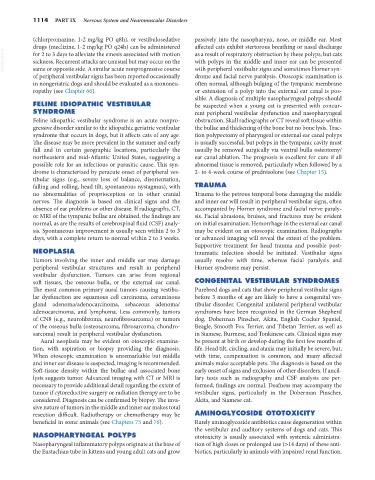Page 1142 - Small Animal Internal Medicine, 6th Edition
P. 1142
1114 PART IX Nervous System and Neuromuscular Disorders
(chlorpromazine, 1-2 mg/kg PO q8h), or vestibulosedative passively into the nasopharynx, nose, or middle ear. Most
drugs (meclizine, 1-2 mg/kg PO q24h) can be administered affected cats exhibit stertorous breathing or nasal discharge
VetBooks.ir for 2 to 3 days to alleviate the emesis associated with motion as a result of respiratory obstruction by these polyps, but cats
with polyps in the middle and inner ear can be presented
sickness. Recurrent attacks are unusual but may occur on the
same or opposite side. A similar acute nonprogressive course
drome and facial nerve paralysis. Otoscopic examination is
of peripheral vestibular signs has been reported occasionally with peripheral vestibular signs and sometimes Horner syn-
in nongeriatric dogs and should be evaluated as a mononeu- often normal, although bulging of the tympanic membrane
ropathy (see Chapter 66). or extension of a polyp into the external ear canal is pos-
sible. A diagnosis of multiple nasopharyngeal polyps should
FELINE IDIOPATHIC VESTIBULAR be suspected when a young cat is presented with concur-
SYNDROME rent peripheral vestibular dysfunction and nasopharyngeal
Feline idiopathic vestibular syndrome is an acute nonpro- obstruction. Skull radiographs or CT reveal soft tissue within
gressive disorder similar to the idiopathic geriatric vestibular the bullae and thickening of the bone but no bone lysis. Trac-
syndrome that occurs in dogs, but it affects cats of any age. tion polypectomy of pharyngeal or external ear canal polyps
The disease may be more prevalent in the summer and early is usually successful, but polyps in the tympanic cavity must
fall and in certain geographic locations, particularly the usually be removed surgically via ventral bulla osteotomy/
northeastern and mid-Atlantic United States, suggesting a ear canal ablation. The prognosis is excellent for cure if all
possible role for an infectious or parasitic cause. This syn- abnormal tissue is removed, particularly when followed by a
drome is characterized by peracute onset of peripheral ves- 2- to 4-week course of prednisolone (see Chapter 15).
tibular signs (e.g., severe loss of balance, disorientation,
falling and rolling, head tilt, spontaneous nystagmus), with TRAUMA
no abnormalities of proprioception or in other cranial Trauma to the petrous temporal bone damaging the middle
nerves. The diagnosis is based on clinical signs and the and inner ear will result in peripheral vestibular signs, often
absence of ear problems or other disease. If radiographs, CT, accompanied by Horner syndrome and facial nerve paraly-
or MRI of the tympanic bullae are obtained, the findings are sis. Facial abrasions, bruises, and fractures may be evident
normal, as are the results of cerebrospinal fluid (CSF) analy- on initial examination. Hemorrhage in the external ear canal
sis. Spontaneous improvement is usually seen within 2 to 3 may be evident on an otoscopic examination. Radiographs
days, with a complete return to normal within 2 to 3 weeks. or advanced imaging will reveal the extent of the problem.
Supportive treatment for head trauma and possible post-
NEOPLASIA traumatic infection should be initiated. Vestibular signs
Tumors involving the inner and middle ear may damage usually resolve with time, whereas facial paralysis and
peripheral vestibular structures and result in peripheral Horner syndrome may persist.
vestibular dysfunction. Tumors can arise from regional
soft tissues, the osseous bulla, or the external ear canal. CONGENITAL VESTIBULAR SYNDROMES
The most common primary aural tumors causing vestibu- Purebred dogs and cats that show peripheral vestibular signs
lar dysfunction are squamous cell carcinoma, ceruminous before 3 months of age are likely to have a congenital ves-
gland adenoma/adenocarcinoma, sebaceous adenoma/ tibular disorder. Congenital unilateral peripheral vestibular
adenocarcinoma, and lymphoma. Less commonly, tumors syndromes have been recognized in the German Shepherd
of CN8 (e.g., neurofibroma, neurofibrosarcoma) or tumors dog, Doberman Pinscher, Akita, English Cocker Spaniel,
of the osseous bulla (osteosarcoma, fibrosarcoma, chondro- Beagle, Smooth Fox Terrier, and Tibetan Terrier, as well as
sarcoma) result in peripheral vestibular dysfunction. in Siamese, Burmese, and Tonkinese cats. Clinical signs may
Aural neoplasia may be evident on otoscopic examina- be present at birth or develop during the first few months of
tion, with aspiration or biopsy providing the diagnosis. life. Head tilt, circling, and ataxia may initially be severe, but,
When otoscopic examination is unremarkable but middle with time, compensation is common, and many affected
and inner ear disease is suspected, imaging is recommended. animals make acceptable pets. The diagnosis is based on the
Soft-tissue density within the bullae and associated bone early onset of signs and exclusion of other disorders. If ancil-
lysis suggests tumor. Advanced imaging with CT or MRI is lary tests such as radiography and CSF analysis are per-
necessary to provide additional detail regarding the extent of formed, findings are normal. Deafness may accompany the
tumor if cytoreductive surgery or radiation therapy are to be vestibular signs, particularly in the Doberman Pinscher,
considered. Diagnosis can be confirmed by biopsy. The inva- Akita, and Siamese cat.
sive nature of tumors in the middle and inner ear makes total
resection difficult. Radiotherapy or chemotherapy may be AMINOGLYCOSIDE OTOTOXICITY
beneficial in some animals (see Chapters 75 and 76). Rarely aminoglycoside antibiotics cause degeneration within
the vestibular and auditory systems of dogs and cats. This
NASOPHARYNGEAL POLYPS ototoxicity is usually associated with systemic administra-
Nasopharyngeal inflammatory polyps originate at the base of tion of high doses or prolonged use (>14 days) of these anti-
the Eustachian tube in kittens and young adult cats and grow biotics, particularly in animals with impaired renal function.

